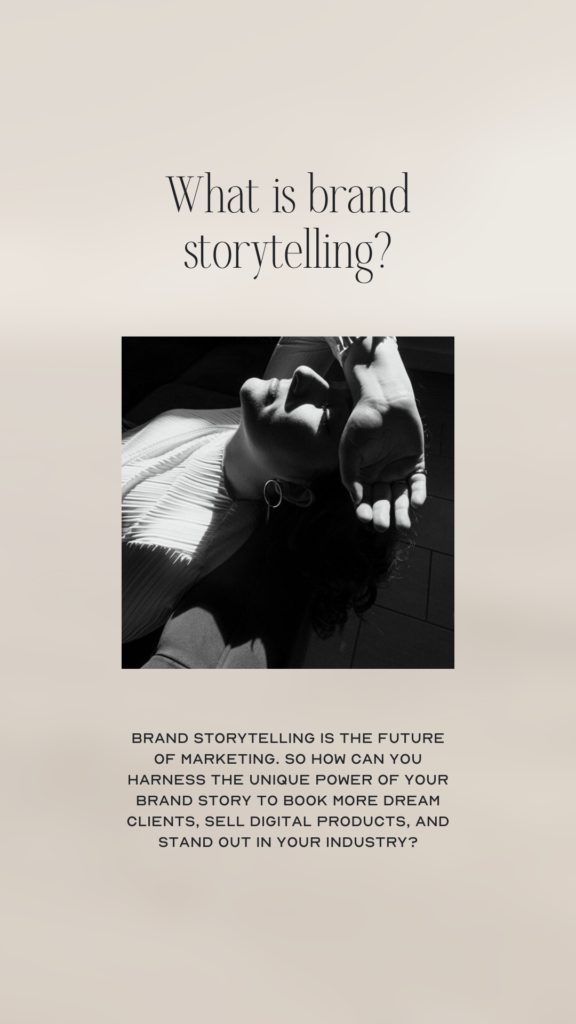Guess what? Brand storytelling is the future of marketing. So how can you harness the unique power of your brand story to book more dream clients, sell digital products, and stand out in your industry?
For starters, you can go beyond simply showing what you sell and how you deliver your service to demonstrate the very ways that you’re making an impact on clients’ lives.
That is the basis of brand storytelling. Essentially, it’s the use of narrative to evoke emotion in your audience so they’ll fall in love with what you’re doing and want to be part of it by joining your customer base and shouting from the (digital) rooftops how freaking awesome your brand is.
Read on to learn more about what it is, why you should care, and how to add it into your business toolbox.
What is brand storytelling?
Brand storytelling is “the act of using an emotion-evoking narrative to connect your brand to customers, with a focus on creating empathy by linking what your brand stands for with the values you share with your customers.”
To break it down, we’re using storytelling techniques (you know, the ones you learned about in English class while skimming Cliff Notes) to build a brand message full of authenticity but guided by momentum and ROI.
An example includes the use of brand archetypes to define the character, voice, and heart of your brand. We can also use testimonials (the kind that show us the before, during, and after of working with you) to write copy on services and sales pages that mirror the transformation a client can expect to see instead of just telling people to buy or descending into scare tactics to make people purchase.
Basically, we want to connect what you & your customers believe in, value, and care about to the outcomes of your service so they can see a clear and obvious intersection between the two. This makes people not only want to buy, but it also creates loyalty around your brand.
In using narrative as part of your marketing, that means you can use creative writing approaches to make copy more original and creative (that may mean using dialogue, conflict, conversational language, heroes and villains, etc.) to connect on a deeper level and speak a client’s language.
When you do this, it helps to go back to your childhood and think of the bedtime stories and fairy tales that were read to you at bedtime. These stories offer a basic structure that underlie nearly every book, movie, play, and, yes, brand story out there.
It’s been said by scholars that there are only so many story types in the world, that we are essentially retelling the tales that have been in existence for thousands of years.
That may seem depressing (as in, if you think about it too much you’ll start to feel like there’s no way you can create something original), but it’s quite freeing to realize that you don’t have to invent the wheel to tell a good story. (yay!)
If you’re interested, books like The Seven Basic Plots, 20 Master Plots, and The Hero and The Outlaw show us how these plots work in action.
Building a Storybrand is also a good resource around this (and directly applicable to creating messaging), but we can take the conversation even further by differentiating between ‘brand messaging’ and ‘brand storytelling.’

Brand Messaging vs. Brand Storytelling
If you hang around spaces where digital marketers talk about things like brand messaging and brand storytelling, it may feel tempting to conflate the two together. But there’s a clear difference between them.
It’s is the set of narrative devices we use to actually write and execute within our marketing. Meanwhile, brand messaging is the set of language, approaches, and strategies we use to show meaningful differentiation in your brand.
While brand storytelling is the execution (could be the copywriting on your sales page or an Instagram caption), brand messaging includes larger brand items like taglines, clarifiers, mission, vision, values, etc, that lead the strategy forward.
To bring this down to earth, that basically means that storytelling would be a component of your brand messaging guide. Brand messaging is an umbrella encompassing storytelling that shows your brand’s history, position in the market, value prop, and overall uniqueness in the market.
Why You Should Care? Hint: it’s the foundation of Messaging.
So why the heck do we care? It sounds interesting, but can it really work? This article on Linkedin demonstrates how stories make brands more memorable, drive long-term growth, and communicate your purpose as a business, but here’s some tangible stats:
Researchers at Stanford found that stories are 22x more memorable than facts alone. How is that for staying on your customer’s mind?!
Still not sure? This approach even worked for Refinery29. The marketing team tested a storytelling ad next to a more traditional ‘subscribe’ ad to see how it would perform. The storytelling ad gave them an 87% increase in page traffic and a 56% increase in subscription rates.
In other words, stories grab attention. That’s why they work so well.
Copywriting is Much Better When You Use Storytelling
It may come as a surprise that you need brand messaging before copywriting, but believe me, it pays off.
During the brand messaging process, we gather data around the business: who the ideal client is, what they want to be known for, current products/services versus the new directions they’re heading in. Otherwise, your copywriter will just be guessing. Do you really want that when you could get a better ROI by implementing strategy?! Didn’t think so.
We take that and transform it into a message by conducting customer and brand research. Often, you’ll find your message in your client testimonials, but something to remember is that it is also within you, the business owner. This is especially true for small businesses, where your passion is leading the ship.
While you may be in the business to make money and pay bills, it pays to follow your passion so you can work with people you like, who like you, who are so excited to pay premium prices to work with you.
How to Add Brand Storytelling to Your Business Toolbox
Before you write anything for your brand, conduct customer research. Collect testimonials, ask yourself key questions, brain dump your ideas before trying to wrangle them, and do your research before writing copy. I highly recommend coming into your copywriting prepared because you’ve removed the guesswork and know your core stories ahead of time.
You may also start a swipe file of ads, webpages, and social posts that embody excellent storytelling. You can also keep key stories and brand language in a document you can refer back to often. This is something we create for clients when they book a copywriting service. What can also help is outlining before your write, and allowing yourself to play instead of working at a pressured pace.
If all this seems daunting, hiring a copywriter is also a solid idea. No matter how you pursue those dream clients, start with story and you’ll get there.
Are you ready to level up your brand message this year? Check out Map Your Message, a workshop that will help you position your brand for excellence.
issued on
February 11, 2022
Coming Soon
Accessible copywriting resources
for business owners
templates, workshops, & guides
The Copy Society is getting an update! In the fall, we're launching a digital product shop with website copywriting templates and ways to get support as you DIY your copy. Add your email below to be made aware when we launch. You'll also receive our twice-monthly newsletter, To The Letter.
